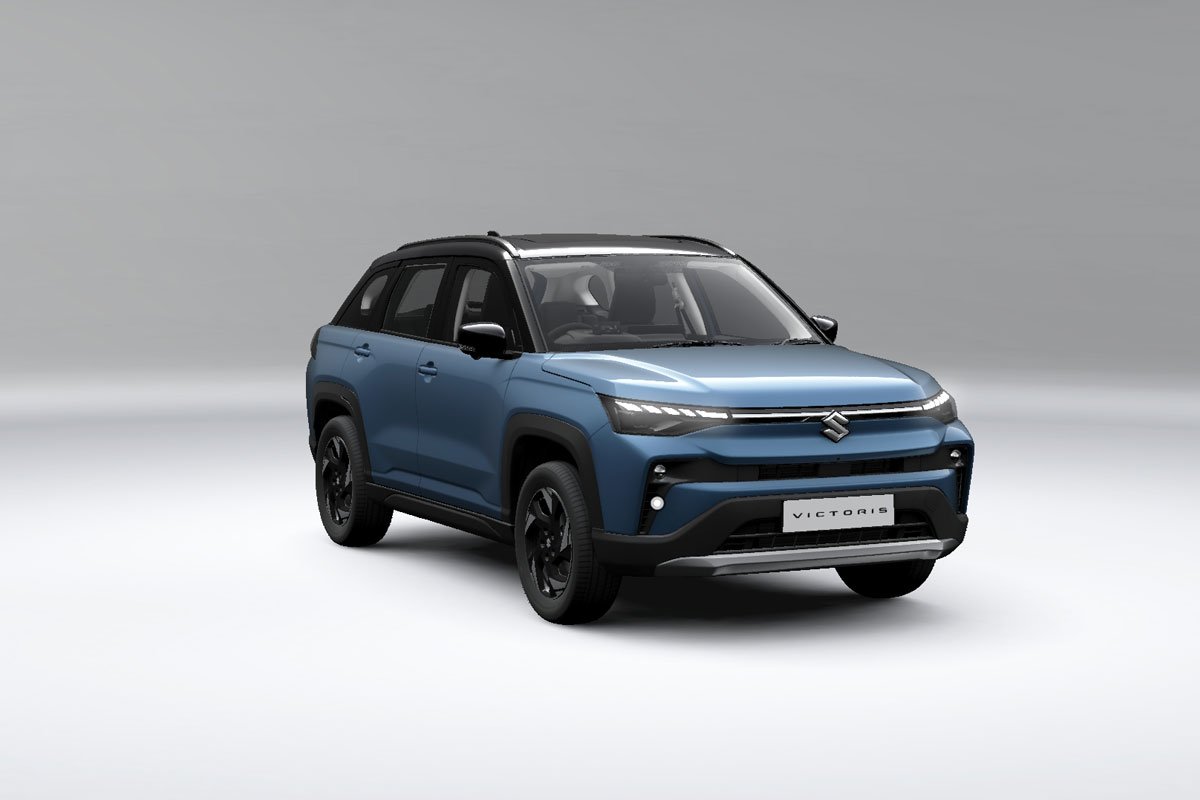The Victoris is the latest mid-size SUV from Maruti Suzuki in India, launched in September 2025. It is positioned above the Brezza in Maruti’s Arena lineup, offering more premium features, higher safety, and more powertrain options.
The name “Victoris” comes from Latin, meaning “victory.”
Design & Dimensions
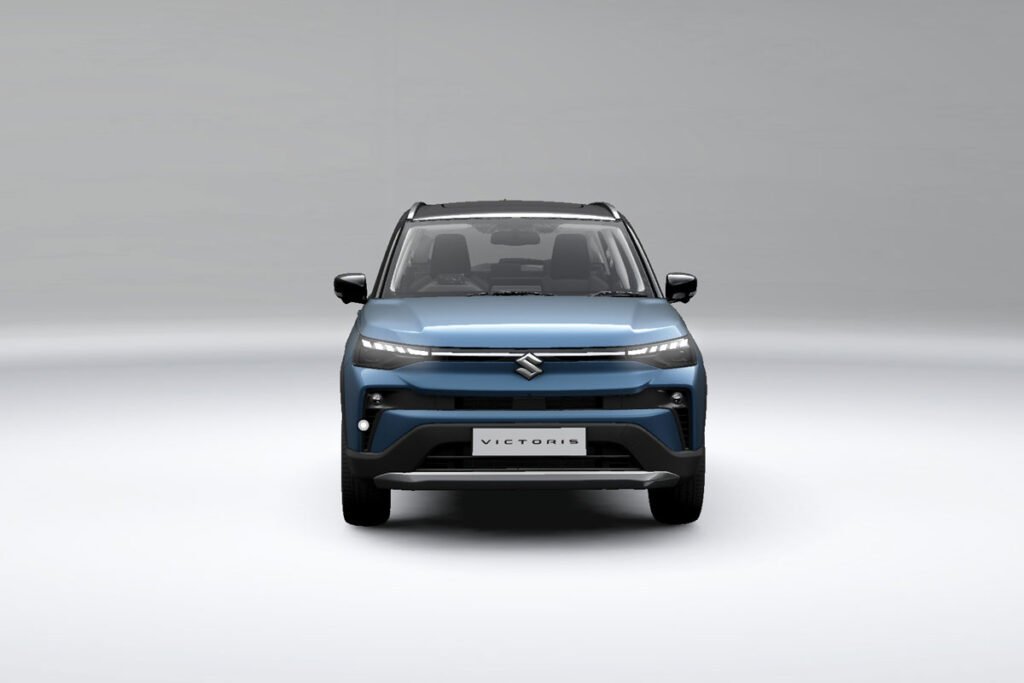
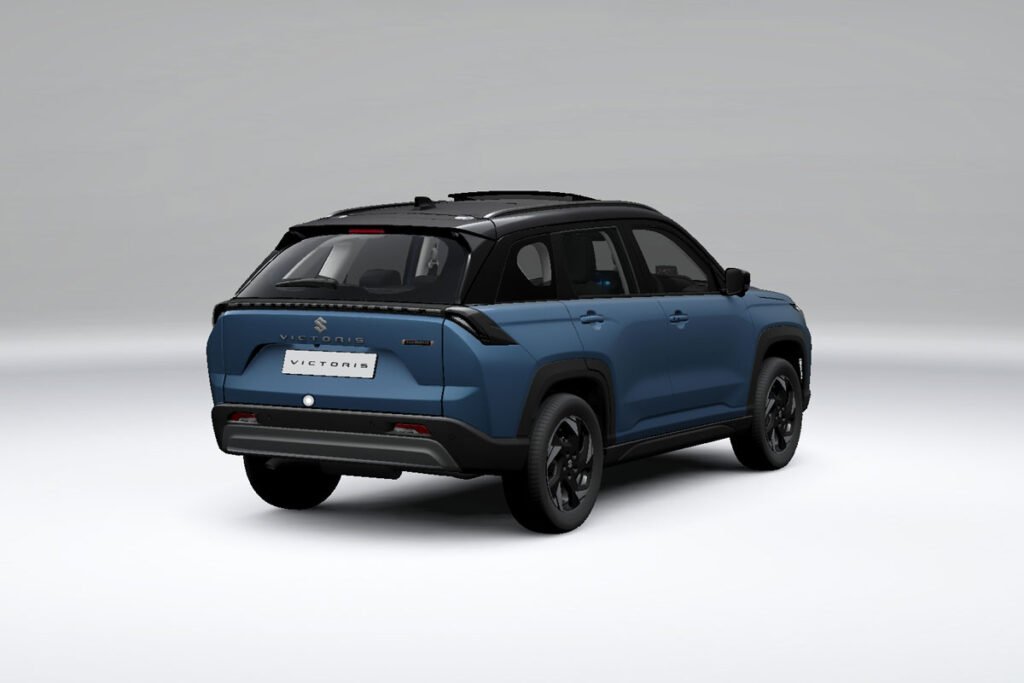
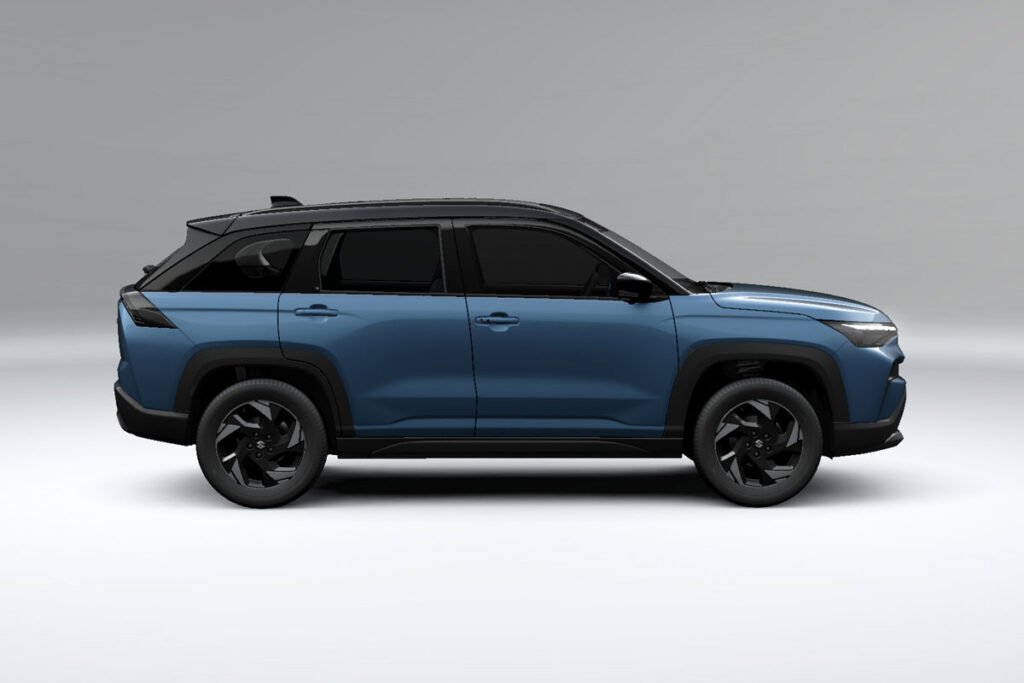
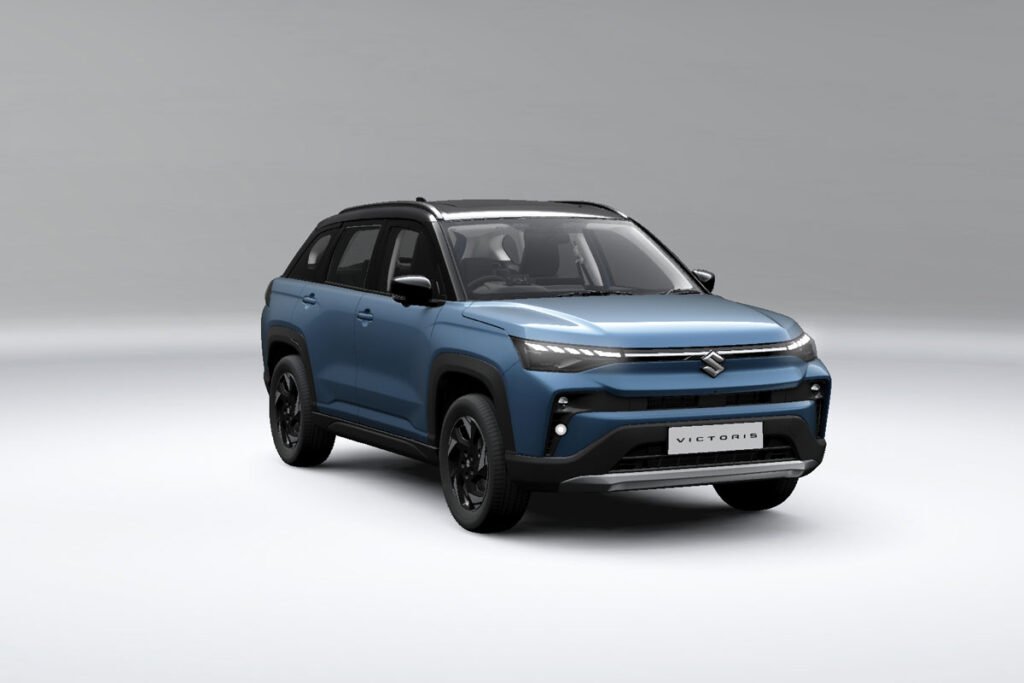
- Exterior styling is modern and sleek: LED projector headlamps, a slim look, connected LED tail-lamps, and roof rails. It rides on 17-inch alloy wheels (215/60 profile tyres).
- Dimensions:
- Length: 4,360 mm
- Width: 1,795 mm
- Height: 1,655 mm
- Wheelbase: 2,600 mm
- Ground Clearance: 210 mm
- Colours & personalisation: Available in 10 exterior shades (7 monotone + 3 dual-tone), including fresh hues like Mystic Green and Eternal Blue. There’s a “Raffin Package” that adds dark chrome styling, skid plates, dual-tone seatcovers, illuminated sill guards, etc. Interior theme is black + ivory with soft-touch surfaces, piano black inserts, and textured upholstery. Panoramic sunroof available on higher trims.
Features & Technology
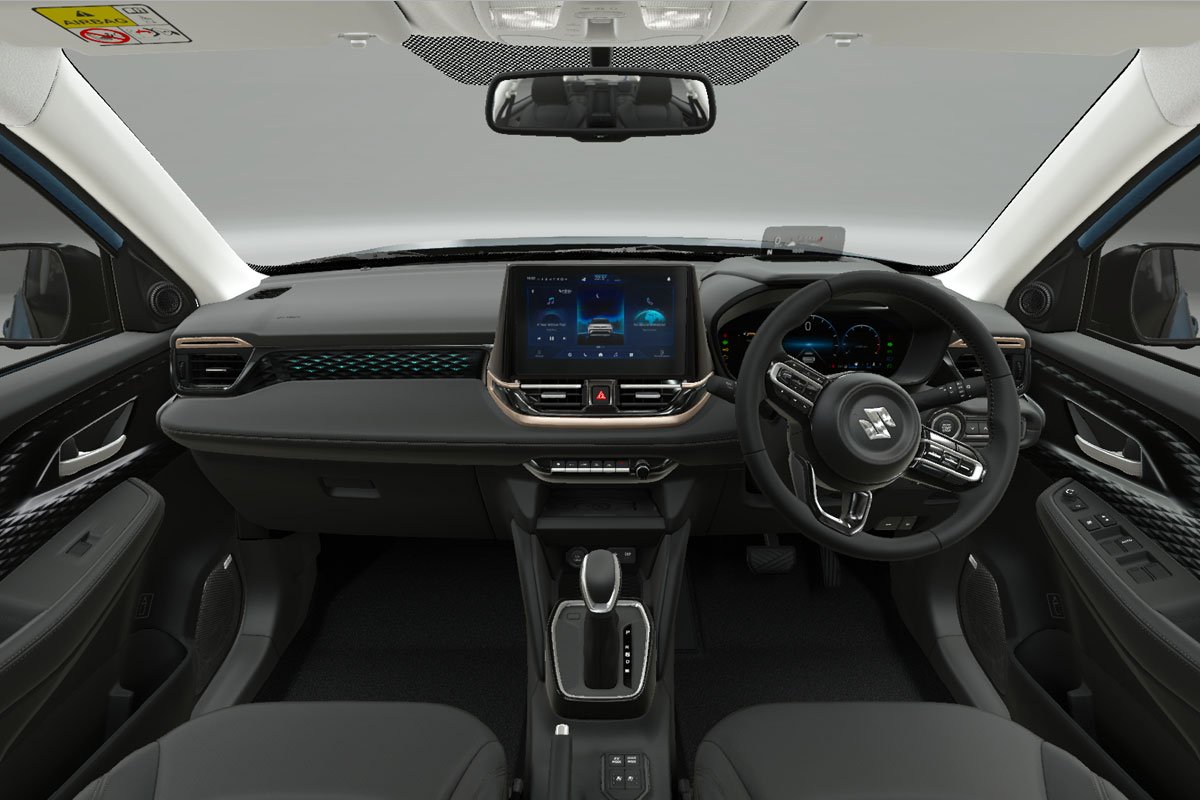
The 2025 Maruti Suzuki Victoris is loaded with tech and comfort features, signifying a strong push in Maruti’s offering.
- Infotainment & Digital Cockpit
• 10.25-inch fully digital instrument cluster.
• 10.1-inch “SmartPlay Pro X” touchscreen infotainment system, with wireless Apple CarPlay / Android Auto, built-in apps, OTA (over-the-air) updates, and Alexa Auto Voice AI. - Audio
• Segment-first Infinity by Harman 8-speaker system, with Dolby Atmos / 5.1 surround sound. Maruti markets it as a “theatre-on-wheels”. - Comfort / Convenience
• Ventilated front seats, 8-way powered driver’s seat.
• Powered tailgate with gesture control.
• Wireless charging (with active cooling), multiple USB-C ports, PM2.5 filter with AQI display, 64-colour ambient lighting. - Safety & Driver-Assistance
• Level-2 ADAS (Adaptive Driver Assistance) is one of its big USPs: features like adaptive cruise control with curve speed reduction, lane keep assist, blind spot monitoring, rear cross-traffic alert, high beam assist, automatic emergency braking, etc.
• 5-star Bharat NCAP rating. For adult occupant safety, it scored 31.66/32; for child occupant, 43/49.
• Other standard safety gear: 6 airbags, ABS with EBD, ESP, tyre pressure monitoring, 360-degree camera system, all-wheel disc brakes, electronic parking brake with auto-hold.
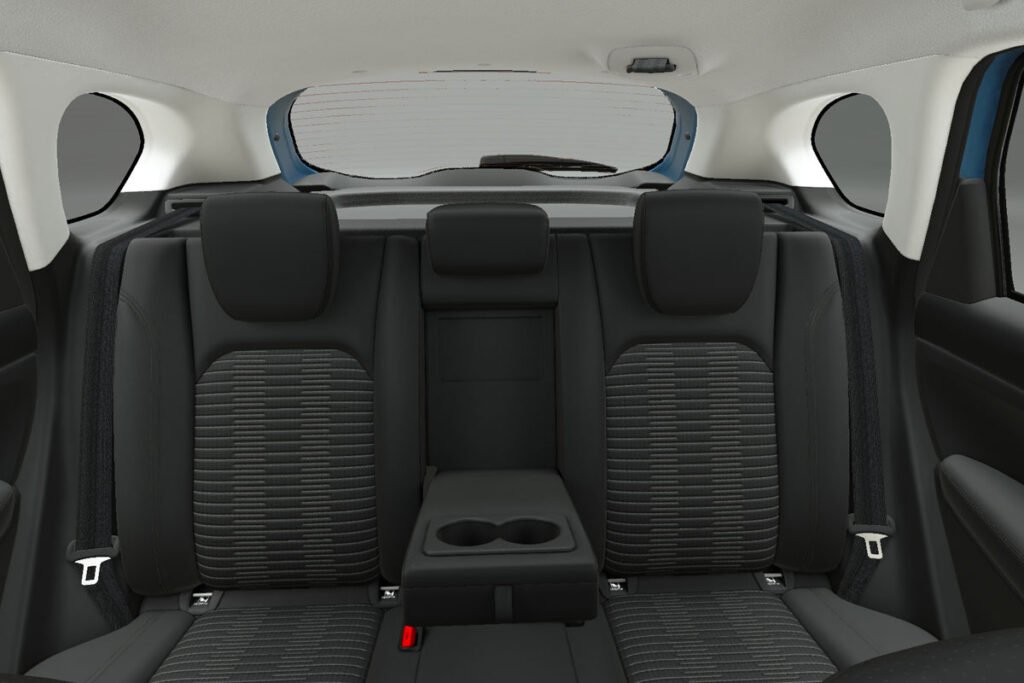
Powertrains & Performance
Victoris offers multiple engine/fuel/transmission options, giving buyers flexibility according to their priorities (efficiency vs power vs terrain ability).
Here are the key options:
| Powertrain Type | Engine / Fuel | Transmission | Performance / Torque / Efficiency |
|---|---|---|---|
| Petrol (K-series 1.5 L NA) | 102 bhp, 139 Nm | 5-speed manual or 6-speed automatic | Mileage 21.18 km/l (MT) & 21.06 km/l (AT) |
| Strong Hybrid (1.5 L) | 116 bhp, 141 NM via e-CVT | e-CVT automatic | Efficiency around 28.65 km/l |
| S-CNG | 87 bhp, 121.5 Nm | 5-speed manual | 27.02 km/kg for the CNG version, with an underbody tank design so boot space is not majorly compromised. |
| ALLGRIP Select (4×4) | Only available with 1.5 NA Petrol, 102 bhp, 139 Nm | 6-speed automatic, with multi-terrain modes & hill descent control | Mileage 19.07 kmpl |
Pricing & Variants
2025 Maruti Suzuki Victoris is offered in six trims: LXI, VXI, ZXI, ZXI(O), ZXI+, and ZXI+(O).
Prices (ex-showroom, India) start from about ₹10.50 lakh for base petrol trims. The higher trims (with AT, hybrid, or ALLGRIP 4×4) go up to around ₹19.99 lakh for the top strong hybrid version.
2025 Maruti Suzuki Victoris – Rivals Comparison
Here’s how the Victoris stacks up against the big players in the mid-size SUV segment:
| Feature / Spec | Maruti Suzuki Victoris | Hyundai Creta | Kia Seltos | MG Hector | Toyota Hyryder |
|---|---|---|---|---|---|
| Length | 4,360 mm | 4,330 mm | 4,365 mm | 4,655 mm (larger) | 4,365 mm |
| Wheelbase | 2,600 mm | 2,610 mm | 2,610 mm | 2,750 mm (most spacious) | 2,600 mm |
| Engines | 1.5L Petrol (NA), 1.5L Hybrid, 1.5L CNG | 1.5L Petrol, 1.5L Turbo 1.5L Diesel | 1.5L Petrol, 1.5L Turbo, 1.5L Diesel | 1.5L Petrol, 2.0L Diesel | 1.5L Petrol (NA), 1.5L Hybrid, 1.5L CNG |
| Power (max) | 141 bhp (hybrid), 103 bhp (NA) | 160 bhp (turbo), 114 HP (NA) | 160 bhp (turbo), 114 bhp (NA) | 141 HP (Turbo Petrol) 168 bhp (2.0L Diesel) | 116 bhp (hybrid) |
| Mileage | Up to 28.65 km/l (hybrid), 21+ km/l (petrol), 27 km/kg (CNG) | 17–19 km/l | 17–19 km/l | 14–16 km/l | Up to 27.97 km/l (hybrid) |
| Infotainment | 10.1-inch SmartPlay Pro X + 8-speaker Dolby Atmos | 10.25-inch screen, Bose audio | 10.25-inch screen, Bose audio | 14-inch vertical display | 9-inch screen, JBL audio |
| Unique USPs | Hybrid + CNG + AWD options, 360 camera, powered tailgate, ventilated seats | Turbo petrol fun-to-drive + widest service network | Sporty looks + diesel option | Huge size, road presence, panoramic roof | Best hybrid tech + Toyota reliability |
| Price Range | ₹10.50 – 19.99 lakh | ₹10.73 – 20.50 lakh | ₹10.79 – 19.81 lakh | ₹14 – 20.76 lakh | ₹10.95 – 19.76 lakh |
How It Stacks Up / Market Position
- It’s meant to compete with popular mid-size SUVs in India like the Hyundai Creta, Kia Seltos, MG Hector, Toyota Hyryder, etc.
- Key strengths: very strong safety credentials, a wide variety of powertrains, tech features (especially for the price), and flexible use cases (city, highway, some off-road via AWD).
- Possible compromises: The petrol NA version has modest power compared to turbocharged rivals; rear seat comfort and space might be less generous compared to some rivals; the cost of ownership of hybrid / AWD variants could be higher.
Pros & Cons of Maruti Suzuki Victoris
Pros:
- Best-in-segment efficiency with 28.65 km/l hybrid & 27 km/kg CNG.
- 5-star Bharat NCAP rating – strong safety confidence.
- Level-2 ADAS (Adaptive cruise, lane keep assist, AEB, etc.) – segment-first for Maruti.
- Multiple fuel choices – Petrol, Hybrid, CNG, AWD – rare flexibility.
- Premium features: ventilated seats, powered tailgate, 360-camera, panoramic sunroof, Dolby Atmos audio.
- Wide service network – Maruti’s biggest advantage over rivals.
Cons:
- No turbo petrol/diesel option – rivals are still better for power seekers.
- Rear seat space is not generous.
- Hybrid & AWD variants priced high – top models touch ₹20 lakh.
- Design is conservative compared to sporty Seltos/Creta.
Frequently Asked Questions (FAQ) on Maruti Suzuki Victoris
Q1. What is the price of Maruti Suzuki Victoris in India?
Prices start at ₹10.50 lakh (ex-showroom) and go up to ₹19.98 lakh for the strong hybrid / AWD variants.
Q2. Which engines are available in the Victoris?
1.5L Petrol (NA), 1.5L Petrol Strong Hybrid, and 1.5L CNG. AWD available with petrol.
Q3. What is the mileage of Maruti Victoris?
Petrol 21 km/l, Hybrid 28.65 km/l, CNG 27 km/kg.
Q4. Does the Victoris come with a diesel option?
No diesel option is offered. Maruti focuses on hybrid & CNG instead.
Q5. Is Victoris safe?
Yes, it scored 5 stars in Bharat NCAP, with excellent ratings for both adult & child safety.
Q6. Does Victoris get ADAS features?
Yes, it’s Maruti’s first car with Level-2 ADAS, including adaptive cruise, lane keep assist, blind spot monitoring, and AEB.
Q7. Who are the main competitors of Victoris?
Hyundai Creta, Kia Seltos, MG Hector, Toyota Hyryder, Tata Harrier (higher segment overlap).
Q8. Is AWD available?
Yes, in higher petrol variants with Maruti’s ALLGRIP Select AWD.
Q9. Which is better – Victoris Hybrid or Toyota Hyryder Hybrid?
Both share similar hybrid tech (Toyota-Suzuki partnership), but Victoris offers more features, while Hyryder has Toyota’s brand trust.
Q10. Should I buy Victoris?
If you want safety, efficiency, ADAS, and multiple fuel options in a premium mid-size SUV, the Victoris is a great choice. If you want more powerful turbo/diesel engines, Creta or Seltos may suit you better.
Verdict / Who It’s For
Victoris seems ideal for buyers who want a single SUV that “does it all”:
- You care a lot about safety and want advanced driver assist features.
- You want modern tech & premium touches without paying a luxury brand premium.
- You appreciate options: maybe you prefer hybrid or CNG, or need AWD.
- You drive both in the city and on highways, with occasional rough roads.
If you’re more focused on outright power (e.g. wanting a turbo engine) or maximum rear seat comfort, you might find trade-offs.

